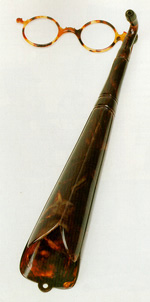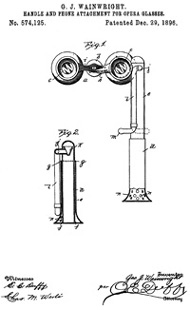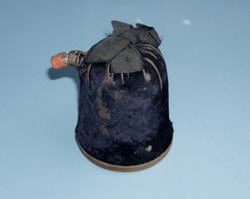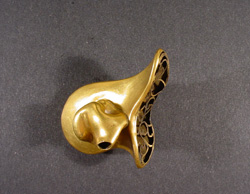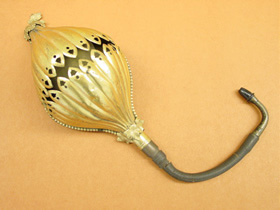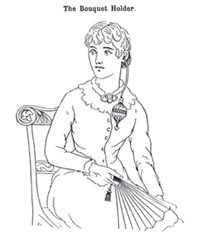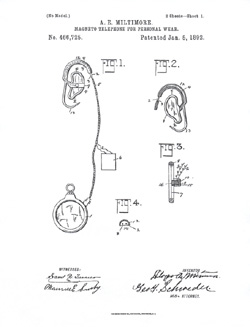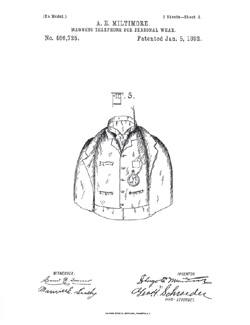Concealed Hearing Devices of the 19th Century
In the 19th century, hearing trumpets were built into opera glasses, binoculars and lorgnettes, combining acoustic benefit with vision enhancement in a single design.
| Mourning Trumpets | |
|---|---|
| One example of a disguised hearing trumpet was the “mourning trumpet,” aptly named as they were covered with black fabric, leather, lace, and ribbon to blend in with clothing typically worn by women in mourning of a loved one. Many styles and sizes of mourning trumpets were available for women during the 19th century and according to the Hawksley Catalogue, they were “suitable for use in public.” | |
Courtesy of the Baldwin Collection, Western Michigan University Department of Speech Pathology and Audiology |
|
Courtesy of the John Q. Adams Center for the History of Otolaryngology - Head and Neck Surgery, American Academy of Otolaryngology-Head and Neck Surgery Foundation |
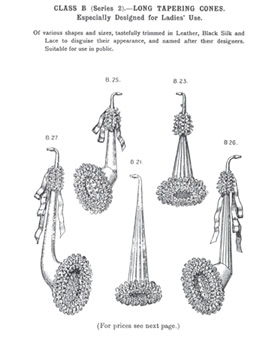 |
Long Tapering Cones from the Hawksley catalog |
|---|---|
| These ear trumpets were “Especially Designed for Ladies’ Use” and “of various shapes and sizes, tastefully trimmed in Leather, Black Silk and Lace to disguise their appearance.” Each model was named after its designer – the “Bradley,” the “Brady,” and the “De Hamel.” The Hawksley catalog further stated that these ear trumpets “are very portable for their strength and are conveniently carried by a silk cord attached to the dress or round the neck.” |
“Sensitive persons, particularly ladies, have an aversion to advertising their affliction in public by the use of many of the usual forms of hearing instruments. To meet this very natural objection, such instruments have been ingeniously combined with fans, parasols, umbrellas, muffs, handbags or reticules, bouquet holders, opera glasses, &c. Other instruments are attached to the head and ears, and may be concealed by the cap, hat, bonnet or hair. . . . For gentlemen, walking sticks and umbrellas of various sizes have powerful sound collectors fitted to them; also dinnerplate holders and field glasses and the inside of the ordinary silk hat.”
— Hawksley Catalogue of Otacoustical Instruments to Aid the Deaf, 1895
A variety of accessories disguising hearing devices were manufactured during the 19th century. Two exquisite examples of accessories or adornments are an artificial concha and a bouquet holder.
| Artificial Concha | |
|---|---|
| This beautiful artificial concha, from F. C. Rein, London, about 1830, is made of gold-plated silver with a filigreed grill covering. The concha, custom-designed and molded for an individual user, would have been worn as a self-retaining adornment that could blend in with a hairstyle or jewelry. Acoustic measurements of the concha reveal up to a 13 dB gain over a limited frequency range centered at 1.5 kHz. This gain is considerable for the size of this device, and would benefit a person with a mild hearing loss. View a frequency gain chart for the Artificial Concha View an Object VR movie of the Artificial Concha |
|
|
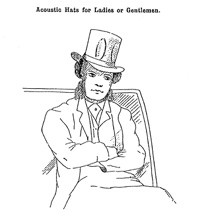 |
| Hawksley Acoustic Hat catalog illustration |
|---|
Hats were another convenient means of concealing hearing devices. Tiny ear trumpets and listening tubes were concealed within or beneath the hat, with the ear pieces discreetly held in place by attached springs and covered with silk or felt.
 |
Derby Hat Patent |
|---|---|
| The Derby hat patent was based on the bell-shaped hat acting as a sound receiver with the sound transmitted to the user’s ear via a single acoustic tube protruding from the center of the hat. In the words of the inventor, W. G. Bonwill: “To all appearance the hat is an ordinary one, and a casual observer would not detect the presence of an ear-trumpet within.” |
Hearing devices using electricity were conceived during the last decades of the 19th century – though none were successfully completed until the first years of the 20th century. Concealed devices, such as the “Magneto-Telephone for Personal Wear,” featured a transmitter disguised as a “badge or other ornament” that could be worn outside of the clothing or concealed in a pocket.
| “Magneto-Telephone for Personal Wear” patent drawings | |
|---|---|
| This 1892 patent is the earliest known U.S. patent issued for an electric hearing device. However, the device was probably never manufactured. | |
<< Previous | 1 | 2 | 3 | 4

